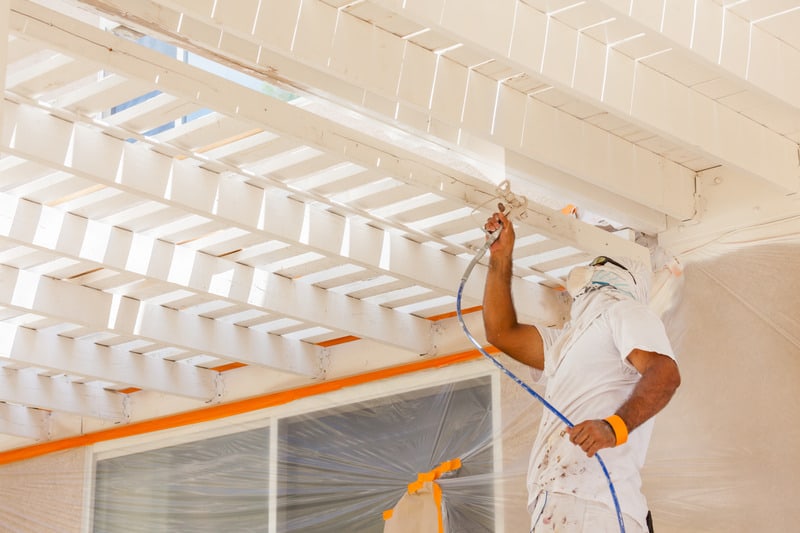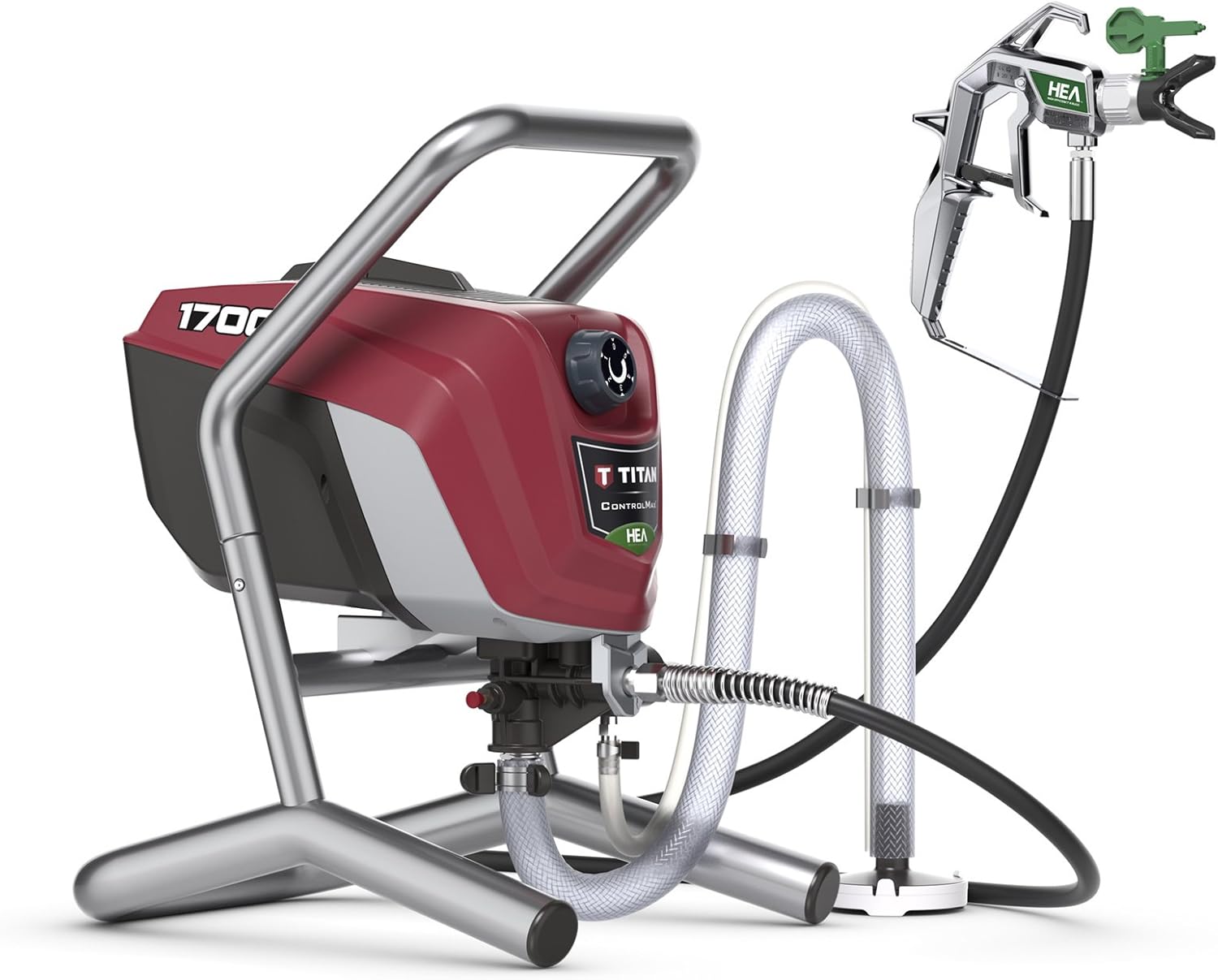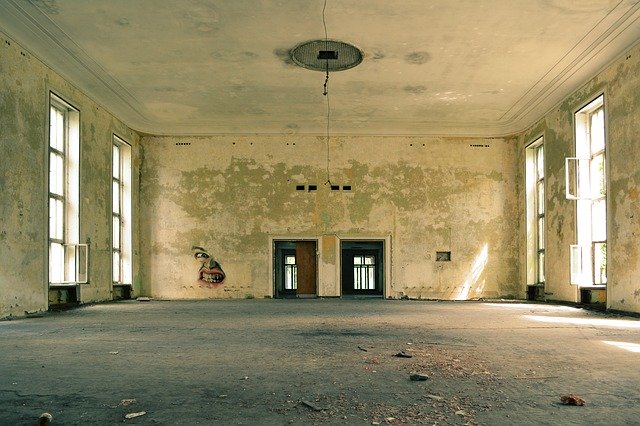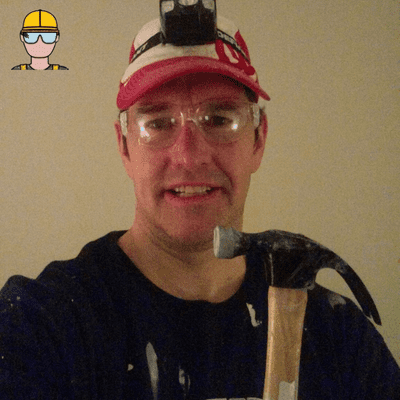Best Paint Sprayers for Ceilings – Top 10 Recommendations
TheToolGeeks.com is a participant in the Amazon Services LLC Associates Program and other affiliate advertising programs. We may earn from qualifying purchases. (Learn More).
Painting your house ceiling can be easy and quick if you use a paint sprayer. Since there are many paint sprayers to choose from, you want to pick the right sprayer for your project type (ceiling size, paint type, etc.). That’s why we set our Tool Geeks team on a mission to find the best paint sprayers for ceilings for our readers.
But what if this will be your first time using a paint sprayer and need an idea of the factors to consider when painting your ceiling or the specific features of a sprayer?
We’ve got your back, as we’re here with our in-depth review of each feature and how it will help you in your painting job. To come up with the best paint sprayer list for you, we tested some paint sprayers on multiple ceilings and interviewed some of our customers who have used sprayers for their feedback.
Best Paint Sprayer for Ceilings – Quick Comparison
Type: HVLP
Flow rate: 0.135 gallons/minute
Weight: 2.11 pounds
Type: HVLP
Flow rate: 0.07 gallons/minute
Weight: 3.3 pounds
Type: Airless
Flow rate: 0.33 gallons/minute
Weight: 19.4 pounds
Type: Airless
Flow rate: 0.38 gallons/minute
Weight: 19 pounds
Type: Airless
Flow rate: 0.2 gallons/minute
Weight: 4.5 pounds
Type: HVLP
Flow rate: 0.25 gallons/minute
Weight: 4.14 pounds
Paint Sprayer Types For Ceilings
Apart from different features, there are also different paint sprayer types, as shown on our list. Here are the top 3 paint sprayer types that you need to consider.
Airless
Airless sprayers are mainly for larger indoor and outdoor areas, such as walls, ceilings, siding, decks, and fences. They have a lot of power and pressure to reach the ceilings. Plus, they are very fast, so you can be able to complete the project faster.
Airless sprayers use an electric pump to transfer paint from the cup or bucket and to spray tiny drops with high pressure, over 1,000 psi. Due to their high power, they can handle thicker and regular paints, oil paints, and primer, especially with multiple coats. But they also can overspray, so cover or mask up surrounding areas accordingly.
Since they have much power, these paint sprayers can also spray thick materials such as latex paint. But, these paint sprayers tend to cost more.
Compressed Sprayers
The most used sprayers for ceilings are compressed sprayers. These sprayers use an air compressor to transfer paint from the cup/bucket to the spray tip and a regulator to control the amount of paint flow on the surface. They are the conventional sprayer for walls, cabinets, furniture, and vehicle painting.
Compressed sprayers are pretty fast, and you can get smooth results with them. They can handle thicker and thinner paints, including latex, wood stain, varnish, and lacquer. They usually provide higher pressure and less overspray compared to Airless sprayers.
You don’t have to break the bank to buy it, compressed sprayers don’t cost a lot of money and are easy to use too. But, they tend to over-spray and they use more paint, so you may need to refill the paint cup/bucket more often.
High-Volume Low-Pressure Sprayers
As you can guess from the name, this sprayer sprays a lot of paint but uses very low pressure. They aren’t that fast, but they give you a superior finish.
HVLP sprayers use a turbine to atomize the paint, a regulator to control the pressure and liquid flow, and usually have a gravity-fed paint cup. They spray at a lower pressure, 10 psi+, and typically have less overspray compared to regular compressed air sprayers. They also use less paint (in comparison with the airless and compressed air ones).
HVLP sprayers are good for cabinets, furniture, smaller wall areas, railings, door frames, and trim areas. They can handle regular paints, latex, primer, wood stain, varnish, and lacquer. HVLP sprayers are lower cost, easy to use, cover most home painting needs, and are good for beginners
If you have a big budget, then I suggest you go with airless paint sprayers. Suppose you don’t, then the other two choices are good. Always make sure to calculate that some of them use more paint and some of them don’t.
One note: the ‘sister’ sprayer of the HVLP is the LVLP (Low Volume Low Pressure) sprayer. However, we don’t recommend them for ceilings or walls, as their pressure is usually too low. LVLP sprayers are used mainly for auto body, vehicle painting, some woodworking applications, and precise surface areas, but not general home projects, such as ceilings, walls, and trim areas.
Best Paint Sprayers for Ceilings – Top 10 Picks Tested & Reviewed
1. Graco Magnum 257025
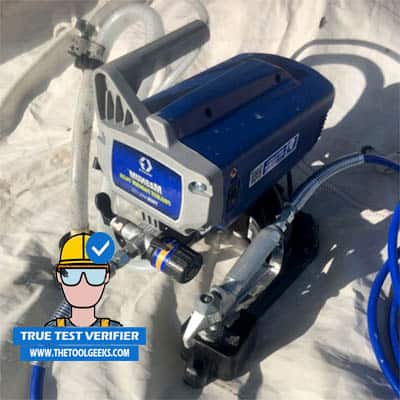
Best Features
- Beginner-Friendly
- Powerful
- Durable
More detailed review ↴
If you are looking for a paint sprayer with enough power to paint ceilings and it’s easy to use, then you need to check our favorite paint sprayer for ceilings, the Graco Magnum 257025. The reason it’s our favorite sprayer is that we also use it for different paint jobs in our workshop. This paint sprayer has a very powerful 3/8 HP motor.
Is this paint sprayer fast?
The manufacturer claims that it can spray up to 0.24 gallons per minute. But can it do that? We tested it, and technically it can. But, while spraying, you have to stop, move, and do other things, and you can only spray the whole time, so don’t expect to spray 0.24 gallons every minute (This flow rate may vary).
It’s fully adjustable, meaning you can control the paint flow according to the surface area. This is good, especially if you will be working on different surfaces. You can adjust the pressure to match the project you are working on. This makes this sprayer versatile.
What sets this product apart from its competitors is that it can spray unthinned paint; the piston pump that this sprayer comes with gives the tool enough power to deal with different kinds of paints and offers a clean finish.
What we like about this sprayer is that you can use the paint directly from the paint bucket. This is good for us because we don’t have to refill the color often while working and don’t need a big paint cup.
On the downside, the hose is 50ft. (which is good), but it can easily curl up on you if you need to be more careful. And, the sprayer clogs too often; you may need a wrench to un-stuck it.
Beginner-Friendly: Made for DIYers and homeowners.
Powerful & Fast: Comes with a 3/8 HP motor that can spray up to 0.24 gallons per minute.
Adjustable: You can control the pressure and the paint flow.
50 Ft. Paint House: Extremely helpful, especially if you are dealing with hard-to-reach areas (ceilings).
The sprayer clogs too often.
The hose can curl up on you.
2. Wagner Spraytech 0518080 – Best Spray Gun for Ceiling
- HVLP
- You can use different paints
- 20 ft. Hose
More detailed review ↴
The Wagner Spraytech 0518080 is an HVLP paint sprayer that uses low pressure but sprays a high volume of paint. It’s mostly made for homeowners, but it’s not limited to. I usually use this one only for home-improvement projects (including ceilings) because the cleaning process is easier than most sprayers in this list.
When unpacking, you will realize that it comes with a stationary body and a spray gun. The paint container is inside the stationary body, so you don’t have to carry the weight of the paint; this makes this paint sprayer very lightweight.
Most of the control buttons are on top of the stationary body. Once you turn this sprayer, it will blow up air non-stop. But you will have to pull the trigger to start painting.
Moreover, it has 3 different spray patterns (horizontal, vertical, wide, and narrow) that you can choose to match the project you are working on. The buttons are on the spray gun, so it’s easier for you to push them. It has a powerful 2-stage motor that develops pressure from 1.50 to 2.63 PSI.
It can spray most of the paints. We have tested it with latex and primer paint. It gives you an OK finish with latex paint, but not as good as our first pick. But, it gives you a perfect result if you use primer paint.
Powerful: It has a two-stage turbine motor that can handle different paint types.
Pressure Control: You can adjust the pressure from 1.50 – 2.63 PSI according to your project.
It comes with a 20ft. paint hose, allowing you to move easily throughout your room. We found it difficult to attain a clean and detailed finish.
3. Wagner Spraytech 0529010 – Best Wagner Paint Sprayer for Ceilings
- Two Nozzles
- X-Boost Turbine
- Fast
More detailed review ↴
If you are looking for a sprayer that you can use to spray almost everything in your home, then the Wagner Spray Tech 0529010 is your best friend. This sprayer can be used for ceilings, furniture, trim, etc.
This one, too, is a paint sprayer from the Wagner brand; compared to our second pick, this one doesn’t come with a stationary body, and you will have to carry the weight of the paint. But it can hold less paint, and you can move around without taking the bulky stationary body.
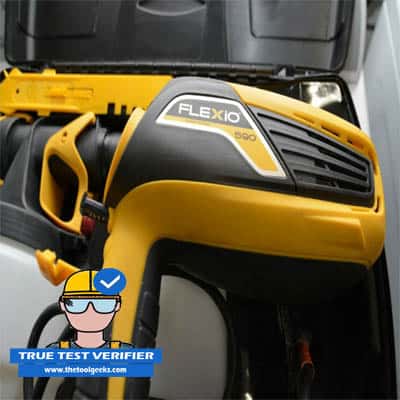
What we like about this sprayer are the nozzles (iSpray & Detail Nozzle). The manufacturer claims you should use one for larger projects and the other for smaller ones. But that’s not true at all.
From our experience, both nozzles do a great job whenever that’s a small or large surface. It just depends on what type of finish you need. Use the detail nozzle for a fine finish and the iSpray nozzle for a normal finish.
Unlike most sprayers, this one can spray unthinned paint, and you can also change the process’s speed. It comes with 10 different rates. We rarely use the fastest steep settings because it doesn’t deliver a high-quality finish as the slower speeds do.
The manufacturer claims that it can spray an 8″x 10″ surface within 5 minutes, so we tested it. The results? It can spray an 8″ x 10″ surface within 5 minutes, but is it worth it? No, you won’t get a good finish if you do that.
On the downside, the design of this sprayer isn’t made for ceilings. The tall back body only allows you to see where you are spraying. It’s suitable for normal spraying but not as good for ceilings.
Two Nozzles – iSpray nozzle for large projects and detail nozzle for small projects.
Powerful – It comes with an x-boost turbine with 10 different speed settings.
Adjustable – You can adjust the paint flow and choose different spray patterns.Not the ideal sprayer design for ceilings. The back of the sprayer is bulky.
4. Graco 16Y385 – Best Ceiling Paint Sprayer
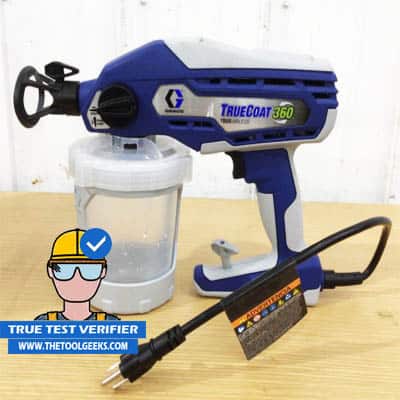
Best Features
- Beginner-Friendly
- Small
- VacuValve Technology
More detailed review ↴
For our budget pick, we have the Graco 16Y385. Although this sprayer isn’t as good as the other “Graco” sprayers, it will do its job for small projects. We mainly use this because of the piston pump. The pump allows us to use un-thinned paint with this sprayer.
This paint sprayer is mainly made for DIYers who don’t have a lot of spraying projects; it’s not recommended to use more than 25 gallons of paint per year. Therefore, if you have a lot of large projects that you need to work on, I suggest you look into the other sprayers we have listed here.
What I like about this sprayer is that it has a technology that allows you to spray in any direction. Plus, it comes with spraying bags that make the cleaning-up process faster. Once you are done, you can throw the bag and use a new one (you can reuse the bag if you want to).
It’s a small paint sprayer, so storing it won’t be a problem. Plus, it’s lightweight; it only weighs 3.5 lbs.
Small – It doesn’t take much space and only weighs 3.5 lbs.
Reverse Tip – This allows you to reverse the tip, if the sprayer gets clogged while working.
VacuValve Technology – Allows the paint sprayer to spray in any direction.
Uses Paint Bags – Instead of cups, this sprayer uses paint bags.Not recommended for large projects. (It can only handle 25 gallons in a year)
One speed setting only.
5. Fuji 2804-T75G – Best Ceiling Spray Gun
- Professional
- 4-Stage Turbine Motor
- Quiet
More detailed review ↴
Since most of the paint sprayers listed here are for beginners only, here’s one that professionals can use too. This paint sprayer is made from FUJI, a known brand for professional sprayers.
The Fuji 2804-T75G features a powerful 4-stage motor turbine that develops 8.5 psi. This sprayer uses a lot of pressure, and that’s helpful, especially if you want to spray unthinned paint. Except for un-thinned paint, you can spray any known coatings with this sprayer (if appropriately thinned).
This is a stationary paint sprayer just like our second pick. We recommend choosing this one only if you have large painting projects and are somewhat experienced; if not, go for our second pick.
The turbine has a spray gun attached; the spray gun comes with a 600cc Gravity Nylon cup. On the sides of the spray gun, there is a controlling setting where you can control the pattern and the paint volume.
The turbine comes with a paint capacity from 3oz to 1Qt. Although this sprayer doesn’t have any feature to reduce the noise (as most FUJI sprayers have), it still doesn’t make much noise. This is good, mainly if you use the sprayer inside.
The spray gun is non-bleed, meaning 95-99% of the paint will spray directly to the object and not drip down your hands. This helps you to get a better finish quality and, at the same time, saves a lot of paint.
Professional – Made for contractors and professionals, it can also be used for home projects.
Spray gun – The turbine comes with a lightweight spray gun (Easy to handle for ceiling).
Pattern Control Knob – You can adjust the fan pattern from small to large.
Dissipation Box – Ensures that the motor inside doesn’t overheat.
Pricey – Not a wise choice to buy for ceilings.
6. HomeRight Super Finish Max Paint Sprayer
- Adjustable and Powerful
- Fast and Easy to Maintain
More detailed review ↴
HomeRight HVLP sprayer is also one of our favorites, as we use this sprayer with different paint types.
This sprayer has an adjustable nozzle, and you can adjust it horizontally, vertically, or round, allowing you to spray in any direction. We personally liked the increase and decrease option of material output which provides control of material or volume flow.
The spray paint has a 39 fluid ounces capacity, allowing you to handle larger projects. We can use any color or stain with this spray paint: chalk type, milk type, primers, stain, varnish, or enamels. (variety of options to choose from).
You can achieve efficient results with 3 different brass spray tips for different paint types. We recommend using a 4mm tip for primer paints, while 2 mm is ideal for chalk paint and 1.5mm for stains.
It comes with 18-inch power cords, a lid for containers, cleaning brushes, a wrench, a wide spray pattern cap, and a+ fine spray pattern cap,
Other than the ceiling, this spray paint can be used for dressers, cabinets, furniture, etc. This is because of its 450 Watts motor offer, which can handle thicker paints.
It can be used with various paint types.
Powerful motor that allows it to handle thick paints.
Best for beginners: Easy to assemble and reassemble.
Cleaning takes time.
Thicker paint clogs the paint.
7. Titan 0580009 ControlMax Paint Sprayer
- Powerful
- 55% Less Overspray
More detailed review ↴
We heard that Titan ControlMax 0580009 is claimed to be the best sprayer for DIYers and beginner painters. But is it really that efficient?
We tested the sprayer and at least got to know and can confirm that it is a less messy and controlled output sprayer. You can comfortably use the sprayer on the ceiling of your house or office (interior or exterior jobs).
Another fantastic feature is that this airless HEA (high-efficiency airless technology) system automatically reduces overspray by up to 55% while working (gives consistent finishing). As it has up to 0.33 gallons per minute spraying capacity, you can work with it easily using a 515 spray tip.
You can adjust the pressure setting of the sprayers according to your job requirement. Also, you can attach different tips according to your project type.
This sprayer has a 30-foot hose and 19.4 pounds’ weight, making it easier to carry around the room.
It helps avoid over-spraying and provides good finishing.
Can power the unthinned coating.
It has a replaceable fluid section, increasing the life of the sprayer.The tips keep clogging.
8. Graco Magnum X5 Airless Paint Sprayer
Best Features Currently Unavailable
- Adjustable and Controlled Paint Flow
- Reversible Tip
- 75 ft. Long Paint Hose
More detailed review ↴
After testing this on a cardboard ceiling (for experimental purposes), we’re convinced that Graco Magnum Airless Paint Sprayer is a pretty controlled sprayer in terms of paint flow.
Also, this sprayer has a fully adjustable pressure feature (like 1,2,3,7, and 9 from our list of best paint sprayers), allowing you to set your desired pressure (according to your paint job).
You can use it for any project because the stainless steel piston pump allows you to paint unthinned paint through high pressure.
The spray paint has flexible suction tubes, which provide an opportunity to paint from a 1-5 Gallon paint bucket.
Although the manufacturers recommend not using this paint sprayer for more than 125 gallons in a year. But we beg to differ, as we have this one in our use as well, and recommend not to exceed 100 gallons/year.
The sprayer has a flush adaptor that can be connected to the garden hose, which makes cleaning easy and faster.
You can reach many places during projects through its 75 ft. paint hose, which works on 110 volts and has a fantastic feature that allows you to reverse the tip in case of clogging, and you can keep spraying.
Lightweight and long hose – Easy to transfer.
Pressure adjusting system – Helps in handling multiple-sized projects.
Reverse tip to avoid paint clogging.
The hose is long; it keeps folding.
9. Graco 17A466 TrueCoat
- Can Spray in Any Direction
- Adjustable
- 18-inch Long Power Cord
More detailed review ↴
Graco 17A466 is a popular paint sprayer by Graco because of its excellent results and capabilities.
The paint sprayer comes with high and low-speed adjustments so that you can work on small details and larger projects with this one.
As this is made of stainless steel piston pump, you can spray paint unthinned at full high pressure.
We contacted some consumers of this paint sprayer to know the exact yearly usage. According to customers, you should not exceed 25 gallons per year. So, we’d recommend using it for just house or less-frequent use.
The VacuValve technology allows it to spray in any direction, including upside down, as it has an airtight system (paint will not get spilled)
You can easily use it for multi-color projects, and the reversible tip can be reversed in case of clogging to avoid stopping work.
The sprayer weighs 4.5 pounds and has an 18-inch power cord, making it easy to carry and use away from voltage outlets.
Long power cord allows you to move easily.
Can paint in any direction.
Speed adjustments to avoid overspray.
No volume control – It used too much paint when we used this sprayer.
Not recommended for a large area of the ceiling (Small reservoir).
10. Wagner Spraytech (0518050)
- Can Spray Thin Paint Material
- Three Positions Adjustable Cap
More detailed review ↴
Wagner Spraytech 0518050 is the last paint sprayer with high volume and low pressure. As it uses double-duty HVLP technology, you can spray thin materials: sealers, enamel, stains, etc.
The sprayers come with a two-stage rated air turbine allowing a continuous flow of material and air indoors and outdoors.
The best part which persuaded us to add this to our list is that the sprayer comes with a three-position air cap; you can adjust it horizontally, vertically, or in a round pattern. It gives efficient and impressive results for any job with even paint coverage on your ceilings.
We could assemble and disassemble the sprayer in 5 minutes, and as far as cleaning is concerned, we could clean it in just 5 minutes (If you’re slow or a beginner, it will take 5 minutes extra).
The thing which separates this pain sprayer is: It comes with 1-quarter (0.25 gallons) and 1.5-quart (0.375) containers and a measuring cup, allowing you to change the container and carry on your paint job without stopping for refilling.
As this paint sprayer consumes 0.25 gallons/minute, you should expect refilling after every 2 minutes (considering both containers).
Lightweight – Easy to carry and transfer
It took us 5 minutes to disassemble and clean the sprayer
You can spray in any direction. For beginners, it’s challenging to control uneven painting.
Paint clogging.
What to Consider When Buying a Paint Sprayer for a Ceiling Paint Job?
Buying a paint sprayer for ceilings can sometimes be hard. You need one with enough power to reach the ceilings, enough speed to complete the whole project fast, and more.
Since there are many different features that a paint sprayer should have when it comes to painting your ceiling, we have decided to make a buying guide that will list all the features that you need to focus more on.
Extension Tip
As you may know, most paint sprayers are small. So, reaching the ceilings can be challenging, especially if the sprayer doesn’t have enough power. To make this process easier, you can use an extension tip.
The extension tip can be attached to your sprayer, and you can spray objects far away.
Without extension tips, painting your ceiling will be very challenging. As an alternative, you can use ladders, but they cost a lot more. These spray tips also determine the spray patterns. If you have to spray an object, then using the right spray pattern will make it easier.
Paint Capacity
Knowing the capacity of the paint sprayer is essential, as it will help you determine if it suits your job or not. Having a suitable paint capacity will help you to paint your ceilings faster.
If you have a large capacity, the sprayer can hold more paint. More paint capacity also means the sprayer is heavy, and carrying a heavy sprayer while painting ceilings can cause fatigue.
On the other hand, if your sprayer has less paint capacity, you will have to refill the paint cups several times. That’s why it is always important to know how much paint you need and try to find a sprayer with that capacity.
We’ve mentioned each paint sprayer’s gallons/minute capacity in our list so that you can easily select the best paint sprayer according to your needs.
Read: Best Paint Sprayers For Beginners
Gravity-Based Sprayers
You know by now that there are a lot of different types of sprayers that you can choose from. But that doesn’t mean that all of them can be used to spray at an angle. To paint ceilings, you need a paint sprayer that is gravity-based.
While shopping, always make sure to check if the sprayer can be used for ceilings or not. Please choose one of the sprayers we have listed here to save yourself the trouble.
Read: Best Paint Sprayers For Trims
Use
Except for different types of sprayers. There are sprayers for different “people.” Some sprayers are made for professionals or contractors with a lot of experience in this field, and some are made for homeowners. If you don’t have much experience, it’s always a good idea to go with sprayers made for DIYers.
These sprayers are easier to use and don’t cost much money. Moreover, if you are going to use the sprayer only for ceilings, then homeowner sprayers are your best choice.
Safety Measures
Painting the ceiling will make a huge mess. You will have to remove everything from the room (that you are spraying) or cover up the furniture.
To keep yourself safe while painting a ceiling, you should wear a safety mask, safety goggles, and something to cover your whole body.
You don’t want any paint on your clothes. It’s always a good idea to cover up the whole floor too. If you spill paint on the floor and the color gets dry, it can be tough to remove. You want a sprayer that is easy to clean too.
Read: Best Paint Sprayers For Trims
Type of Paint Sprayer
As we’ve outlined at the beginning of our article, there are different pain sprayers. So, you should know which type of paint sprayer suits you and your paint job.
HVLP paint sprayers are high-volume and low-pressure sprayers that do not need a compressor or any other device for pressure because it efficiently works under less pressure. It is also known as turbo.
Pneumatic paint sprayers are ideal for coating cars used for industrial applications. This needs compressed air to protect the paint from the nozzle tip.
While airless is ideal for protective coating, not for decorative coating, at the same time, it has high production and a high-quality finish.
We recommend using HVLP paint sprayers for painting ceilings, as they work efficiently.
Weight of Paint Sprayer
If the sprayer you use for painting your ceiling is heavy, it will become tough to hold it and paint the whole ceiling.
Do you want to take breaks frequently and waste time? We recommend using a lightweight and long-wire sprayer to make it convenient to paint the ceiling.
Read: Best Commercial Paint Sprayers
Ease of Cleaning
The cleaning of the spray gun and paint clogging is one of the most popular complaints from customers or professionals.
So cleaning the spray gun should be easy and not take time. This mostly depends on the material of the sprayer. So, get the spray gun which is easy to disassemble and clean.
Portability
If the paint sprayer you will use on the ceiling is not portable, it will become a headache instead of being convenient. The sprayer should be easily carried and plugged in. For this purpose, we’d recommend using a paint sprayer with less weight.
Additionally, the hose and the power cord should be long enough to reach quickly and not become a hurdle while spraying your ceiling.
Can you adjust the speed?
Most of the paint sprayers we have discussed in this article are adjustable, an outstanding feature of the sprayer, as it allows the user to control the speed of the flow of material.
HVLP or any other sprayer needs to have this feature because you can increase or decrease the flow through this. This means you can work on small details with less speed and cover large areas with high speed.
Additional Accessories
The best accessories the sprayer should come with are caps, containers, and tips. Some sprayers have 3-6 different tips for different material paints.
The sprayer should have a long hose, filters, and strainers.
Nozzle Size
Nozzles are for covering areas differently depending on the required jobs. If the area you are going to work in is large, then you need large nozzles; otherwise, use small ones.
However, we would personally recommend using small nozzles because it is ideal for achieving detailed work.
Is It Better to Roll or Spray a Ceiling?
It seems ideal to use rolling when you are unfamiliar with spraying because it will also give an excellent finish to the ceiling. However, it will take longer because it is a long process.
While with spray paint, I would not say it does not give a good quality finish, the roller seems to provide more good quality finishing because it penetrates the paint on the top layer and makes it a good bond.
It is your preference which one to choose: roller is better but time taking while the spray is also great and faster but needs preparation before using.
Talking about preparation, we will discuss a step-by-step guide to help you prepare your paint sprayer for painting your ceiling.
Read: Best Paint Sprayers For Home Use
How to Paint your Ceilings and Walls Using a Paint Sprayer?
Now that you know which paint sprayer is best for you, it’s time to learn how to use it correctly to get the best results and ensure safety.
- Clear the area under the ceiling you are going to spray paint.
- Secure the areas you are not going to paint: to avoid messing it.
- Masks the sockets and lights (using tape).
- Then, cover the whole floor under the ceiling with any plastic sheet.
- Since you will be spraying above your head, you must google safety. Sometimes, the paint drops, and you need to protect yourself. Using safety goggles is a must.
- Always pre-test the spray before starting to spray
- For smooth coverage, you should maintain a 20-25 cm distance from the right angle.
Next:
- Dilute the paint if required, and there should be a smooth paste: no trails should be left
- Place the suction hose into the paint.
- Press the inlet valve and get it ready to paint
- Insert the tip according to the paint.
How to spray:
- Always start from the edges and corners
- Keep spraying at a constant speed and avoid over spraying in one area
- After spraying the ceiling with a base coat, allow it to dry.
Related: How to Clean Walls Before Painting them?
Conclusion
Spray painting seems easier when you see other people doing it, but it might feel like a headache if you do it alone. However, if you choose the right sprayer according to your paint job requirements, you can get rid of the headache and get that ceiling painted in no time.
Now that you have reached the end of this post, we’re sure that you know the features you need to look into, what type of sprayer you need for ceilings, and, most importantly, you have a list that contains the best paint sprayers for ceilings. With this much information, you have saved yourself a lot of trouble.
Amazon and the Amazon logo are trademarks of Amazon.com, Inc, or its affiliates.
